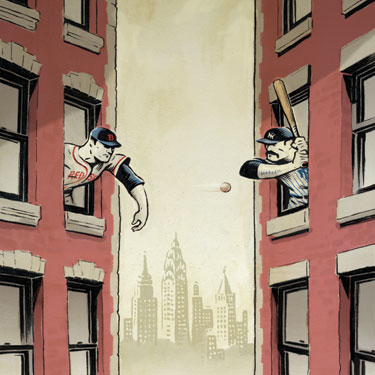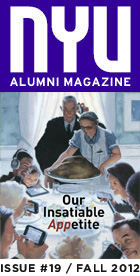psychology
The Enemy Next Door
A new study proves that fear distorts our perceived distance to danger
by Sally Lauckner / GSAS ’10

The adage is most often attributed to Chinese philosopher and general Sun Tzu, but it’s been repeated throughout history by strategists from Niccolò Machiavelli to “godfather” Michael Corleone. And while most understand the logic of keeping tabs on a potential threat, few consider how close we perceive dangers to actually be.
Impressions of the “enemy” are just what Jay Van Bavel, assistant professor of psychology in the Graduate School of Arts and Science, and doctoral candidate Jenny Xiao (GSAS ’13) set out to explore. Their research, published in June in the Personality and Social Psychology Bulletin, focused specifically on how far away people imagine their opponents to be compared to their true distance. Van Bavel believes that a better understanding of our biological adaptation to what scares us might play a role in curtailing discrimination and other negative fear responses. The analysis considered the competition between two local universities, as well as the debate over immigration. But there may have been no better place to begin a study on perceptions of danger than in the Bronx, looking at one of the fiercest rivalries in sports.
“A group that you don’t like can seem a lot closer when they’re threatening,” psychologist Jay Van Bavel says.
Van Bavel and Xiao headed north on the subway in June 2010 to speak with New York Yankees fans as they poured out of the stadium after a game. At the time, the Bombers sat atop the American League East, while archrivals the Boston Red Sox were one game behind in second, and the Baltimore Orioles wallowed in dead last, 23 games out. That night, a majority of Yankees fans incorrectly guessed that Boston’s Fenway Park is closer to Yankee Stadium than Baltimore’s Camden Yards. Because the Red Sox were on the Yankees’ heels in the pennant race, most fans imagined them to be geographically nearer—even though Fenway is 20 miles farther from River Avenue than Camden Yards. “We found that a group that you don’t like can seem a lot closer when they’re threatening,” Van Bavel says.
This flawed perception, Van Bavel adds, may simply be a method of addressing fear. He cites Joseph LeDoux, a professor at NYU’s Center for Neural Science, who draws the analogy of walking in the woods and seeing what may be an animal or a twig. “The advantageous thing to do is to jump,” Van Bavel says. “If you’re wrong and it was just a twig, it only cost you a few calories. But if you didn’t jump and it was a poisonous snake, then you could die.”
Continuing the study, the co-authors turned from baseball to a more serious policy debate. They asked more than 300 NYU undergraduates how threatening they believed Mexican immigration was to American identity. Participants who strongly identified with American pride and who felt that Mexican immigrants were detrimental to the country were more likely to propose that Mexico City is closer to New York City than it actually is. Another study measured the perceived distance between NYU and Columbia University, located in northern Manhattan’s Morningside Heights. For this survey, researchers aimed to manipulate the response. They offered some NYU participants articles that focused on positive comparisons of the two schools; in turn, these participants estimated that the distance between the universities was greater than it is. But other NYU participants who read material that presented Columbia as superior—as an older or more selective institution—presumed that the two schools were physically closer than in reality. “These issues have come up over and over throughout human history,” Van Bavel says. “There have been forms of discrimination that manifest themselves in putting up barriers and segregating groups to certain water fountains. By understanding how perception plays a role in this, we may understand more about the ways to deal with it.”
Van Bavel plans to do more research using this manipulative approach, which foretells that it may be possible to change hostile attitudes or misperceptions toward groups that people view as dangerous. “You can heighten a threat by making Columbia seem more [competitive with] NYU,” he says, “or you can remove that threat by making it clear that Columbia and NYU are two world-class universities in the same city. So we think people are quite susceptible in the way that these things are framed, which is encouraging.”







